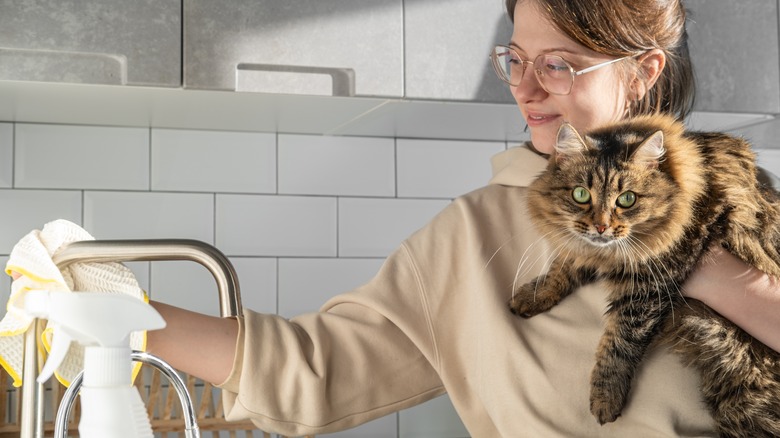Cats are often seen as independent creatures, perfectly content to lounge in a sunbeam or elegantly stalk a rogue toy mouse. However, despite their aloof demeanor, our feline friends have their own preferences and boundaries that can be easily overlooked in the hustle and bustle of daily life. You may think you’re showering your cat with love and attention, but certain habits and routines might actually be rubbing them the wrong way. Understanding what your cat truly dislikes can improve your bond and create a more harmonious living environment for both of you.
In this article, we’ll explore common behaviors that might be irritating your kitty and offer helpful tips on how to avoid these feline faux pas. Whether you’re a seasoned cat owner or new to the furry world, read on to discover how to make your cat purr with happiness instead of cringe with disdain!
Table of Contents
- Understanding Your Cats Body Language and Signals
- Common Household Activities That Annoy Your Feline Friend
- Creating a Cat-Friendly Environment for a Happier Home
- Building a Stronger Bond with Your Cat Through Positive Interactions
- Q&A
- Final Thoughts
Understanding Your Cats Body Language and Signals
Understanding your feline friend’s body language can significantly improve your relationship and keep your cat happy and stress-free. Cats communicate primarily through their body posture, tail position, and facial expressions. Pay attention to when your cat is feeling relaxed; a cat that is comfortable will often exhibit a relaxed posture with ears facing forward, half-closed eyes, and a gentle swaying tail. Conversely, when a cat is agitated or frightened, you might notice its ears flattened against its head, a puffed-up tail, or an arched back. Recognizing these signals can help you gauge how your cat feels about certain situations or stimuli.
Facial expressions provide additional insights into your cat’s mood. A slow blink can indicate trust and affection, while wide eyes might signal excitement or curiosity. Additionally, you should look out for signs like whiskers that are pulled back, which can indicate discomfort or aggression. To create a harmonious environment, it’s essential to respect your cat’s boundaries and recognize when it needs personal space. By observing these subtle cues and adjusting your interactions accordingly, you can avoid common pitfalls and ensure your cat feels safe and loved.
Common Household Activities That Annoy Your Feline Friend
While you may think you’re just going about your daily routine, some common household activities can be quite bothersome for your cat. For instance, loud noises from household appliances can startle them or make them feel unsafe. Whether it’s the vacuum cleaner rumbling through the living room or the blender whirring in the kitchen, these sounds can disrupt their peace. Cats are naturally sensitive creatures, so it’s best to keep these devices to a minimum or use them when your furry friend is in another room.
Additionally, frequent handling or over-the-top cuddling might not be welcomed by your feline companion. Many cats appreciate their personal space and often prefer to approach you when they’re in the mood for affection. Engaging in the following activities can create stress for them:
Excessive grooming – While it’s important to keep them clean, some cats dislike lengthy grooming sessions.
Constant picking up - Not all cats enjoy being held; respect their boundaries.
Playing too rough – Gentle play is ideal; avoid aggressive movements that may scare them.
Creating a Cat-Friendly Environment for a Happier Home
Creating a cat-friendly environment is essential to ensure your feline friend feels safe and content in your home. Start by providing adequate vertical space such as cat trees, shelves, or window perches. Cats are natural climbers and enjoy observing their surroundings from above. Additionally, make sure to have designated hiding spots where your cat can retreat when feeling anxious or overwhelmed. These spaces can be simple cardboard boxes, plush cat tunnels, or covered beds. Remember, offering these areas not only fosters a sense of security but also enriches their environment.
Another key aspect of a cat-friendly home is incorporating interactive play and enrichment items into their daily routine. Consider implementing the following elements to engage your cat’s natural instincts:
Food puzzles: These stimulate your cat mentally while providing a rewarding snack.
Interactive toys: Toys that mimic prey can encourage your cat to exercise and explore.
Scratching posts: Offering various scratching surfaces helps satisfy their instinctual need to scratch while preserving your furniture.
Lastly, ensure your home is free from toxic plants and hazardous materials, as safety is a paramount concern. By creating thoughtful spaces tailored to your cat’s needs, you foster a happier and healthier environment that supports their well-being.
Building a Stronger Bond with Your Cat Through Positive Interactions
Creating a deeper connection with your feline friend can be achieved through understanding their preferences and avoiding actions that may be detrimental to your relationship. Cats are sensitive creatures; what seems harmless to us might be overwhelming for them. For instance, over-petting or forcing affection can lead to stress, causing your cat to withdraw emotionally. Always observe your cat’s body language and respect their boundaries. Here are some common behaviors to avoid:
Ignoring their space: Cats need their personal space to feel safe.
Overstimulation: Too much petting can lead to irritation; watch for signs of discomfort.
Shouting or sudden movements: These can startle your cat and create anxiety.
Instead, focus on enhancing positive interactions that build trust. Engaging in play is a fantastic way to bond; it allows for fun activities that appeal to their instincts. Utilizing toys that mimic prey can stimulate their hunting skills while also encouraging exercise. Remember to reward good behavior with treats or affection when they seek it. Consider these tips to make your interactions more enjoyable:
| Positive Interaction | Benefits |
|---|---|
| Gentle Petting | Builds trust and comfort |
| Interactive Playtime | Stimulates their mind and senses |
| Quiet Time Together | Increases emotional connection |
Q&A
Q&A: Things You Do That Your Cat Actually Hates
Q1: What are some common mistakes cat owners make that their cats dislike?
A1: One of the most common mistakes is using loud voices or sudden movements. Cats are sensitive creatures, and loud noises can scare them. Another mistake is forcing interactions. While some cats may enjoy cuddling, others prefer to approach you on their own terms. Additionally, changing their environment too much or too quickly can cause stress.
Q2: Why do cats dislike being picked up or held against their will?
A2: Cats are natural hunters and have a strong instinct for independence. When you pick them up or hold them, they may feel vulnerable and trapped. It’s essential to respect their personal space and let them initiate contact. Observing their body language can help you understand when they’re open to being held.
Q3: Is it true that cats hate when we use their litter boxes incorrectly?
A3: Absolutely! Cats can be quite particular about their litter boxes. They prefer clean, unscented litter in a quiet location. Using strong-smelling cleaning products or changing the type of litter can deter them from using the box. It’s important to scoop regularly and to provide enough boxes if you have multiple cats.
Q4: How does excessive petting affect a cat?
A4: While many cats enjoy being petted, they have a threshold. Over-petting can lead to overstimulation, causing them to bite or scratch. Recognizing signs of discomfort, like tail twitching or flattening ears, can help you prevent overstimulation. It’s best to pet in short sessions and observe their reactions.
Q5: What about playing with my cat? Are there any tips to make it more enjoyable for them?
A5: Yes! While playtime is essential, using the wrong toys or playing too aggressively can make it less enjoyable for your cat. Choose lightweight toys that mimic prey and allow your cat to stalk and pounce. Also, avoid using your hands as toys; this can encourage biting and scratching. Always let your cat initiate play and give them time to wind down afterward.
Q6: Do cats dislike certain scents?
A6: Yes, many cats have an aversion to strong scents, especially citrus, vinegar, and some artificial fragrances. These smells can cause discomfort or stress. It’s best to keep their environment free from overwhelming scents, especially in areas where they like to relax.
Q7: Can you give me advice on how to communicate better with my cat?
A7: Absolutely! Understanding your cat’s body language is key. Look for signs like slow blinking, tail positions, and ear movements to gauge their mood. Speaking softly and using gentle movements can also help create a calm atmosphere. Daily interaction can strengthen your bond and enhance communication.
Q8: What’s the most important thing to remember when caring for a cat?
A8: The most crucial aspect of cat care is to respect their individuality. Every cat has its own personality and preferences. Pay attention to their likes and dislikes while providing a safe and enriched environment. When you understand and respect their needs, you’ll cultivate a happier, healthier relationship with your feline friend!
Final Thoughts
understanding our feline friends is essential to fostering a harmonious relationship with them. By being mindful of these common behaviors that cats dislike, you can help create a more comfortable and loving environment for your furry companion. Remember, every cat is unique, so take the time to observe their individual preferences and needs. By making small adjustments in your interactions and routines, you can enhance your bond and ensure your cat feels safe and happy in their home. So, the next time you’re tempted to indulge in a habit that might not sit well with your kitty, consider their feelings first. Your cat will appreciate your efforts, and you’ll both enjoy a more peaceful and joyful companionship. Happy bonding!
















